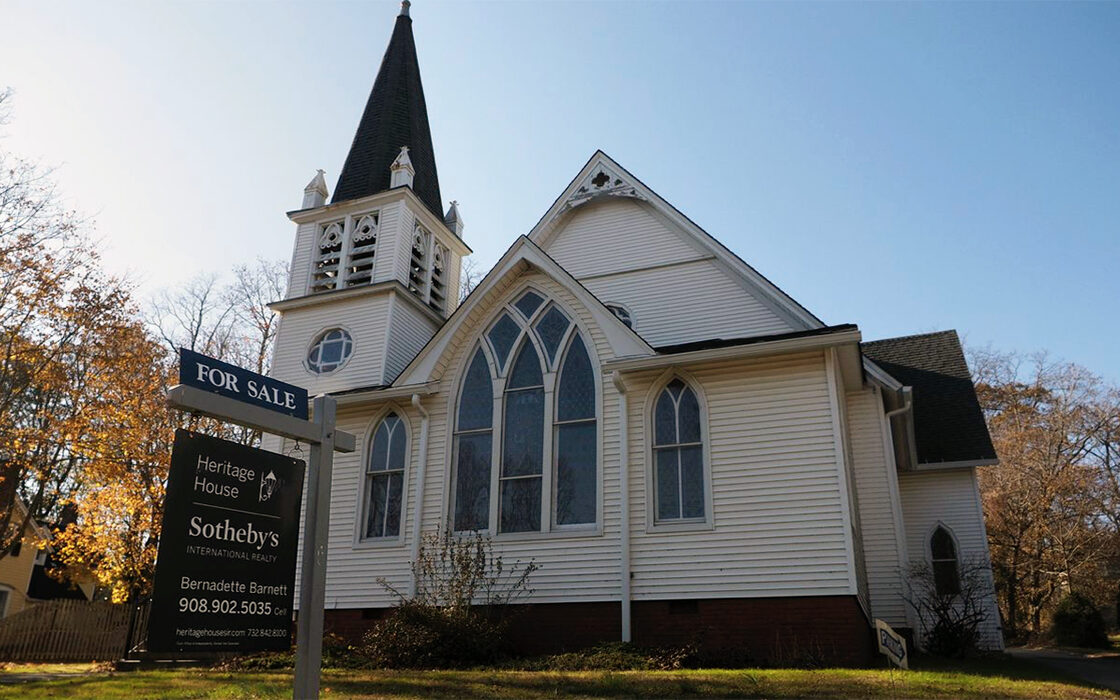The Importance of Porches
In the summer of 1973 my wife Kathy worked for a church in the Germantown neighborhood of Philadelphia when the crime rate in urban areas was far higher than it is today. There she came to see the importance of porches. She was young (23) and the only white girl living in the neighborhood. But many of the leading matrons of the community monitored the world from their porches. They would call to her as she walked down the street, “You’re safe on this block, honey. We’ve got our eyes on you.”
It wasn’t until years later that we heard of Jane Jacobs who, in her classic The Death and Life of Great American Cities, argued that it was the mark of healthy urban life to have “eyes on the street.” Porches were crucial half-way places between the insides of the homes and the street, where residents of the homes could watch the street and where people from the street could fraternize with residents. Blocks in which no one sat out on porches to talk to passers-by and to watch what was happening were desolate and often dangerous. Blocks with lots of porch-sitters were friendly. If you were on a porch and saw someone you knew, you could call them up onto the steps or the porch and talk and even offer them a glass of lemonade or sweet tea on a hot day before they went on their way. Porches were the key to a vibrant neighborhood. [] [1] Jane Jacobs, The Death and Life of Great American Cities, Vintage Press, 1992, 56.
The End of the “Forecourt”
In a series of newspaper articles written from 1907 to 1911, and later collected into a set of volumes entitled Pro Rege, Dutch theologian Abraham Kuyper used an illustration to discuss the relationship of genuine, devoted Christians to the nation’s culture. [] [2] Abraham Kuyper, Pro Rege (Vol 1): Living Under Christ the King (Abraham Kuyper Collected Works in Public Theology), Lexham Press, 2016, John H. Kok, ed. He spoke of the Jewish temple that had a “forecourt,” the most famous being “Solomon’s Porch,” an open space with a roof supported by columns just outside the entrance to the Court of the Gentiles. Christians had their public meetings there (Acts 5:12). It was a half-way space between the “world” and the holy place, just as a porch in a modern house is a half-way place between the street and the inside of the home.

Kuyper argued that for centuries, the cultural institutions of European countries had a “Christianizing” effect on most people in the population. General beliefs in a heaven and hell, in a personal creator God, the authority of the Bible, the need for forgiveness of our sins, sexual fidelity within marriage—all these and more were instilled in the general populations. Genuine, born-again Christians were only a fraction of any European society at the time, but Kuyper in no way despised the nominal Christians who constituted the majority. When nominal Christians came into church to hear the gospel preached, they had been prepared for it all their lives. The message did not sound completely, utterly confusing, or radically contradictory to their moral sensibilities because they had been “on the porch” of Christianity.
European culture was, to use Kuyper’s metaphor, a “forecourt” or porch for the church. It was a half-way place between complete unbelief on the one hand (the “street”) and fervent, heart-faith on the other (the “sanctuary”). On the porch were people friendly and respectful toward Christianity.
But, Kuyper argued “Religion no longer occupies the place it used to in social and public life [of European countries]….The atmosphere that at one time was favorable to religion now in fact suppresses it. In the forecourt [our culture] religion has been hushed up.” [] [3] Ibid, 94. Nominal Christians “who went along for the ride are beginning to abandon the purely historical faith that was handed down to them” and dedicated Christians are feeling that the culture “no longer carries them on its waves; instead they become increasingly weary as they have to swim against the current.” [] [4] Ibid.
Not only was the “forecourt” to the sanctuary going away, but the culture now actively “draws people away from God.” [] [5] Ibid, 104. Kuyper gives some reasons. The rise of science was wonderful, but an ideology was forming, one that said “Here—in science and in technology—is the real solution to all our ills.” Capitalism, too, was bringing more prosperity, but it was also creating a new mindset of materialism that tempted people to live for wealth, comfort, and pleasure. Perhaps most of all, the academy, the media, and the arts all were depicting religion as a burden on human freedom and a limit on human potential. Today when you talk to most people about our need for God, Kuyper wrote, “you feel that they are not only too distracted, too taken up with particulars, but also that the internal spring for directing one’s [inward] life upward has become unhinged.” [] [6] Ibid.
So Kuyper concluded (115 years ago!) that “Christendom” was fading, that the large number of people in western societies who were unconverted but who nonetheless had traditional values and a respect for Christianity were melting away. “The crowds in the forecourt will dwindle away in a matter of years” and “will abandon the forecourt in favor of…the life of the world.” [] [7] Ibid. More and more, the culture will be not a forecourt at all but “the street”— a place where people are completely ignorant of and hostile to Christianity.
When Kuyper spoke, however, this was mainly happening in more elite circles such as the universities. It was not until 30-40 years later, after World War II, that church attendance in Europe really plunged. The secular viewpoint that denied any supernatural or transcendent dimension broke out of academic and artistic circles and began to take hold of the broad population. The church porch had vanished.
The “Exception” of the United States
The United States, however, seemed to be an exception to what was happening in the rest of the West. For almost twenty years after the end of World War II, church attendance surged to its highest levels in history, and Christianity seemed to be thriving here. But in the last 15 years what Kuyper foresaw and what Europe experienced seems to have begun here. Church attendance began to decline, especially among younger people. And the cultural institutions have begun to take an overtly hostile and adversarial stance toward traditional Christian faith.

This has not been a shock to Christians living in the biggest cities on the coasts. For example, when I left my church in the mill-town of Hopewell, Virginia in the mid-1980s, I left a town in which virtually everyone was in the forecourt. As one member of my church told me, “Even the atheists have walked down the aisle to give their lives to Christ at some point in their lives.” When I arrived in Manhattan to plant a church in the late 1980s, I saw here the cultural forecourt was completely gone—you either had fervent believers or else hostility to Christian faith. [] [8] I of course did not have the “forecourt” or “porch” metaphor in my head at the time. I will write more about how my church, Redeemer Presbyterian, developed a ‘church porch’ in my next article in this two-part series.
For most believers who have lived in the U.S. heartland, however, the fast disappearance of the cultural forecourt is a shock that has only begun to be felt over the past five years. Most places (especially in the South and parts of the Midwest and Southwest) still had cultural forecourts filled with people with traditional moral values and general openness to the church and biblical teaching. But several things changed. Before 2001 the enemies to American democracy were atheistic Communists, but then came religious fanatics who flew planes into buildings. After that came the Obergefell decision, and big business and government all began to identify the biblical Christian sex ethic as dangerous bigotry. The rise of social media and the pandemic further insulated people from anyone who didn’t think like they did. Despite the rise of a right-wing media, most younger adults and teens were profoundly shaped by secular and hyper-progressive values online. In response many evangelical Christians in particular took a publicly belligerent tone and engaged in naked power politics.
Suddenly, especially in the minds of younger Americans, Christians were the immoral ones, the cruel ones, the enemies of democracy, freedom, and compassion. In most parts of the country, church growth and church planting became far more difficult. Christians found themselves public targets of criticism for their views, especially on sex and gender. Then the pandemic emptied the churches. And since public services began again, most churches to this day have not yet recovered their former congregations. The American forecourt was emptying; Kuyper’s prediction was coming true even in the United States.
The Failure of the U.S. Church
For nearly 1,000 years, most people in the western world lived on the church “porch.” In Europe most countries had state churches, which were often supported by the government and which people had to attend if they were hoping to “come up” in the world. The U.S. had no national state church (though some states did) yet there were powerful social expectations that a “real American” went to “the church of their choice.”
That meant two things at least. First, it meant that most people felt “attending church is a good thing” and therefore it was not that hard to get them in the door, especially for holy days (Christmas and Easter) or for major life transitions (weddings, funerals, baptisms). Second, when they did attend, preachers could assume that nearly all the visitors had four fundamental beliefs: 1) there is a personal God who created us and who judges us, 2) there is some kind of objective moral standard by which we are judged, 3) no one lives up to that standard perfectly and so we need forgiveness, 4) there is an afterlife, a heaven and hell. If you think for a moment of these beliefs as “dots,” then evangelism for centuries in the West has consisted of simply connecting the dots. Ordinarily this was done by increasing listeners’ sense of guilt and presenting Christ as a solution. Here’s how that may happen:
“You want to be sure you’d go to heaven when you die, right (dot #4)? And you know that will only happen if you live a good life, right (dot #2)? But I can show you that you are not good enough, that you do not live up to the moral standards, and you know in your heart that you don’t, right (dot #3)? Well, God (dot #1) sent his Son Jesus to die in our place and take the punishment we deserve so we can be forgiven and given eternal life as a free gift. Then you can be sure you are right with him. And here are the Bible passages that support this message of salvation I am giving you.”
This is how evangelism has been done in the West and in the U.S. for centuries and, with regard to its basic theological content, this message is perfectly true and accurate. But how does it fall upon the ears of someone who never lived in the forecourt—who lacks any of the “dots?” How do you convict a person of sin if they strongly believe that morality is socially constructed and that we get to define for ourselves what is right or wrong? How do you motivate a person to care about the Christian message if they believe that there is no afterlife at all and that the only happiness that can be grasped is material, this-world pleasure and comfort? How do you speak to someone about salvation if they do not believe in a personal God, but only in a spiritual life force permeating everything? How do you respond to the listeners who are alarmed that you are not allowing people to express and define themselves and that therefore your message is spiritually abusive and exploitative?
As we all know, the number of Americans who “lack the dots” is increasing exponentially in every generation. The older message and methods are becoming less and less effective. In general, the church in the West has not yet done what Lesslie Newbigin, freshly retired from the mission field in India, called it to do in the 1980s and 90s. It must recognize that it is no longer in a Christendom culture that creates a forecourt for it. Most non-believers cannot quickly hear a gospel presentation and be asked if they want to receive Christ. Rather, like the early church and the church throughout the non-western world, congregations in the West must learn to create their own porches or forecourts where people can enter a relational process and be prepared to hear and understand and perhaps embrace the gospel.
That’s what Newbigin wanted and what the church in the West should have done. But old habits die hard. The vast majority of churches continued to reflexively work as if there was still a cultural forecourt. Their ministries and messages implicitly still assume that non-believers will be brought by friends or will simply show up in church and understand what is being preached. Some may, but this will increasingly not be so. This is a lethal kind of spiritual blindness and is a contributing factor to the decline in the church that we are seeing now in the U.S.
Churches Building Porches
There is only one solution. The churches in the United States cannot rely on the culture any longer to constitute a church porch. Congregations must build their own church porches where they can serve lemonade to outsiders who are not yet ready to come all the way into the “house,” but where they can be prepared to do so.
How is that done? What do such porches look like?
We use this metaphor to describe a place where people are exposed to Christianity in both an informative and positive way, outside of ordinary church services and instruction. When I say “place” it is not necessarily a physical space (though it may be that), but a set of relationships. In this space non-believers feel themselves to be not intruders or tolerated onlookers or “probationers,” but loved and fully accepted “ratified participants.”
On porches people are regularly exposed to Christianity in at least three ways: (1) They are enabled to see it. This happens when it is modeled in the lives of individual Christians, but it may also consist of visible expressions of Christianity, whether it be a service in the community (such as caring for the poor), art (such as literature, music, or theater) or in education (such as a Christian school). (2) They must be encouraged to question it. This happens when Christians in the space listen intently, patiently, and with great respect to non-believers’ doubts and questions, and respond with humility and thoughtfulness. Of course the questioning goes both ways. On porches, the powerful and unquestioned cultural narratives—“we are only intolerant of intolerance” and “you always have to be true to yourself” are patiently interrogated. (3) Finally, they must be enabled to hear it. This happens when Christianity is presented in their own language and vocabulary (instead of Christians’ insider jargon), and as answers to the questions that are most on their hearts, fulfilling their greatest aspirations and hopes better than their own intuitions and beliefs.
Church porches that all share these characteristics nevertheless come in an enormous variety of forms. Here are just four. (In the next article in this series we will give many more examples and provide a great deal more detail.)

The original L’Abri center in Switzerland in the 1950s and 60s was a place where young European non-believers could come to live in community with believers, experience deep hospitality, and enter into long conversations about faith and doubt. Some “Christian Study Centers” close to college campuses function in this way today.
A Christian school that has a great reputation in the community for academic excellence and that is attached formally or informally to a particular church can be a church porch for the many non-believing parents who send their children there and participate in the community life of the school.
A service project or program that builds affordable housing or meets other needs of the poor, especially if it is attached to a particular church, can be a church porch for non-believers who regularly volunteer for the program and come with Christian friends.
Small group book clubs, Bible studies or other courses of study in which half or more of the participants are non-believers can serve as church porches.
The original church porch (as we can see from the New Testament) was simply a highly hospitable Christian home, a place to which non-believing neighbors and colleagues are constantly invited and where Christian faith is unselfconsciously modeled and discussed.
Porches and “Subversive Fulfillment”
One of the main marks of an effective church porch is the concept of “subversive fulfillment.” In a nutshell it means that there must be a balance of criticism and clear confrontation of unbelief (“subversive”) along with a great deal of respect and appreciation for the good values, commitments, and aspirations of the non-believers (“fulfillment”).
Every culture is essentially idolatrous. It makes an absolute—a pseudo-god or pseudo-savior—out of some good but fallen created thing, whether it is individual freedom, submission to family, a socialist belief in the power of the state, a capitalist belief in the power of the market, or a populist belief in the superiority of one’s nation, blood, and race. Christians are to show members of other religions and worldviews that Christianity fulfills basic human longings and aspirations, but at the same time, it critiques the false idols in every culture that are looked to for the satisfaction of those longings. “Subversive fulfillment” avoids the twin errors of either syncretism or irrelevance. Sin must not only be denounced in general, but in the particular idolatrous forms found in the culture. Salvation must not only be declared in general, but as fulfilling the very hopes that the culture wrongly puts in its idols.
Dan Strange popularized and promoted subversive fulfillment as a descriptive term and also as a strategy of gospel communication. [] [9] Daniel Strange, “For Their Rock Is Not as Our Rock: The Gospel as the ‘Subversive Fulfillment’ of the Religious Other.” Journal of the Evangelical Theological Society 56/2 (2013) 379–95. Found at https://www.etsjets.org/files/JETS-PDFs/56/56-2/JETS_56-2_379-395_Strange.pdf See also Dan Strange, Plugged In: Connecting Your Faith With What You Watch, Read, and Play, (Good Book, 2019). Dan Strange gets the term from Hendrik Kraemer, “Continuity or Discontinuity,” in The Authority of Faith: International Missionary Council Meeting at Tambaram, Madras (ed. G. Paton; London: Oxford University Press, 1939) 5. So when the gospel is rightly preached, it not only confronts but attracts. It not only appeals and compels, it offends. It says, “the plot-lines of your life will only come to a happy ending in Jesus Christ.” Subversive fulfillment is both affirming and contradicting. It challenges people, but on their own terms. And it means offering them, on gospel terms, what all human hearts rightly need—a meaning that suffering can’t take away, a satisfaction not based on circumstances, a freedom that doesn’t destroy love and community, an identity that doesn’t elude you, crush you, or lead you to exclude others, a basis for justice that doesn’t turn you into a new oppressor, a relief from shame and guilt without resorting to relativism, and a hope that can enable you to face anything with poise, even death.
This means, first, that on the church porch we are seeking to win the respect of non-believers and to affirm some of their beliefs. [] [10] Respect ordinarily is based on what has been called ‘cultural’ or ‘social capital.’ We explain this concept in the second article in this series. We are not merely saying, “We are right and you are wrong.” Rather, we affirm some of their beliefs and reason in this way, “If you believe (rightly) this – then why do you inconsistently believe that?” And then we attract them by showing how the things they seek can only be found in Christ.

We live at a time when many Christians are calling for us to get tough in the public square, to just declare the truth loudly and clearly and not in any way try to be persuasive, to show Christianity’s relevance, or to show Christianity’s attractiveness. Yet we see Paul, when talking to pagans in Acts 14:15-17, saying that God has left a witness in their hearts to his existence. In Acts 17:23-31, he builds his case against idolatry on the insights of the pagan philosophers’ own writers. He both affirms and critiques, he respects and confronts.
Building on Common Grace
This assumes the doctrine of “common grace”—namely, that God restrains the evil and darkness of the world by giving all humans and all cultures some wisdom and insight into truth. [] [11] Peter Leithart wisely argues that in western cultures we not only have ‘common grace’ but also what he calls ‘middle grace’—the residue of many Christian values that remain in the culture. These values—such as the equal and inviolable dignity of every person, the necessity of helping the poor, etc—are adopted even by people who have secular worldviews that actually provide no basis for them.
“But,” someone might object, “did you not say that post-Christendom people lack the foundational beliefs—such as in God and sin—on which to build a gospel presentation?” Yes, I did, but while they may lack explicit assent to these doctrines, all people do know God (Romans 1:21) though they suppress it (Romans 1:18). However, no one can suppress it entirely. Some truth always breaks through.
So in the old cultural forecourts nominal Christians had a religious consciousness. They believed in God, in heaven, and in the Ten Commandments as moral absolutes while today’s secular person insists that there is no God or afterlife, that everything has a scientific, material explanation, that everyone must “live their own truth,” and that morality is just a social construct. And yet a closer look will show that they still have a kind of religious unconscious. (The philosopher Charles Taylor calls these ‘cross pressures’ that most secular people experience.)
At one level they believe their worldview and yet they have indelible intuitions that don’t fit it. They have fleeting senses of beauty or “transcendence”—that there is something more than this world. They know their own beliefs mean that experiences of love and beauty are just chemical reactions developed in our brain for survival and the passing along of our DNA. But they cannot live as if it is true. They say all morality is relative, but they have moral ideals about justice that they do not believe are relative, and so they lack the moral sources for their moral ideals. They also sense the need for a meaning and identity rooted in something bigger than themselves and their own interests.
With the more educated and intellectually oriented, the inconsistencies listed at the end of the last paragraph can constitute an apologetic. But for most people, these “God-shaped holes” in the soul—for meaning, beauty, love, truth, identity—are not so much an argument as an existential problem. On the church porch they get to see how Christianity gives unparalleled resources for them all.
However, on the porch we are not only affirming and fulfilling, we are also challenging and contradicting many cherished beliefs of non-believers. On the porch we must not speak only positively of Christianity’s offers and benefits. The fact is that the Christian life also comes with costs and living in ways that contradict many of the culture’s most fervent beliefs.
But for most people, these “God-shaped holes” in the soul—for meaning, beauty, love, truth, identity—are not so much an argument as an existential problem. On the church porch they get to see how Christianity gives unparalleled resources for them all.
If we only talk of the positive and not of (what the culture considers) the negative, we might bring people to profess faith in Christianity not because it is true, but because it ‘works’ for them personally. But what about the persecuted church in the Middle East and elsewhere and through the ages? Being a Christian brings them social ostracism at least, and imprisonment and death at the worst. Is Christianity working for them, helping them reach their temporal life goals? No. So why do they maintain it even if it brings suffering? Because they believe it is true—whether it is good or bad for their temporal well-being or not. And so on church porches we must not only attract people with the things Christianity offers their hearts, but we must also challenge people with the truth of Christianity and the reasons to believe it.
Conclusion
Churches in a post-Christendom culture need porches. Some will be larger and more formal and others small and informal.The more practical-minded of my readers, however, probably want more details about how these porches can be built and would like more examples of them. So I will write one more article in the quarterly that gives some of that information.
This is the first in a two-part series on how we can continue to share the gospel in the Western world as cultural Christianity fades. Part 2 from Dr. James Eglinton is available here.




